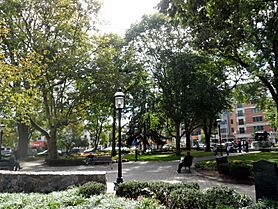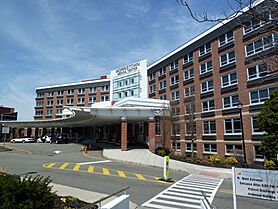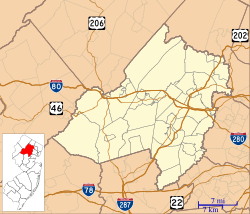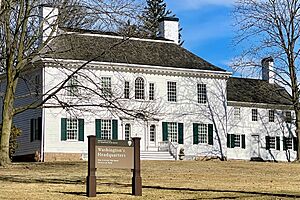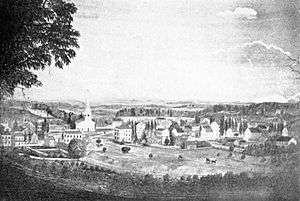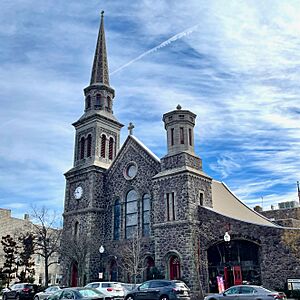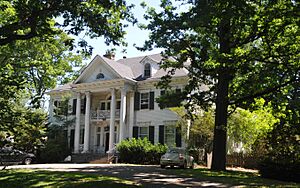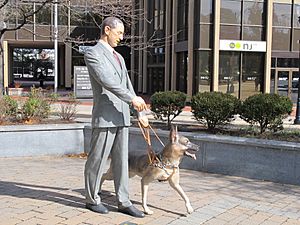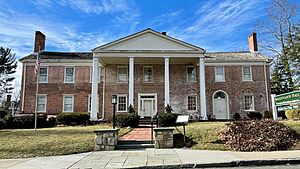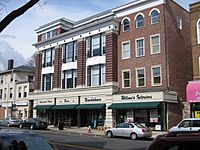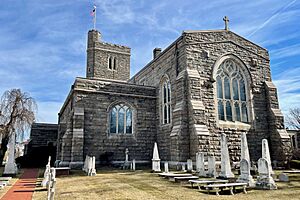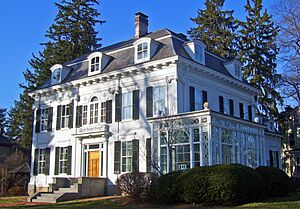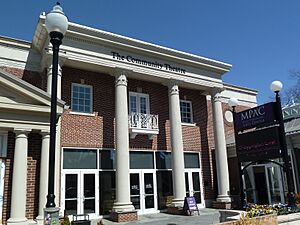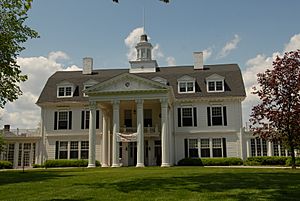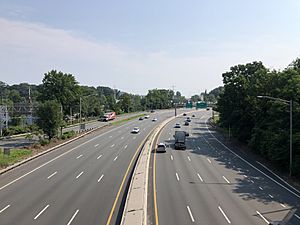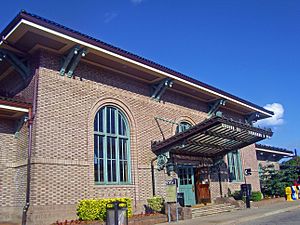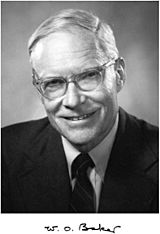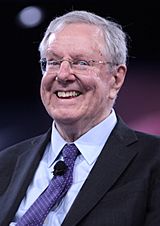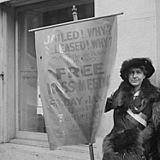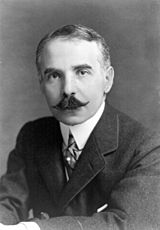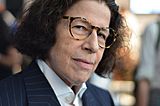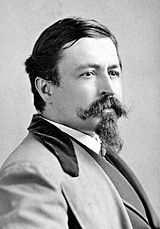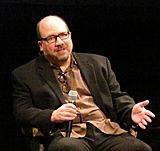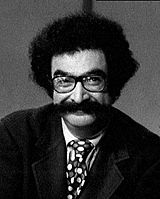Morristown, New Jersey facts for kids
Quick facts for kids
Morristown, New Jersey
|
|||
|---|---|---|---|
|
Town
|
|||
|
Morristown Green, the cultural heart of Morristown
The Vail Mansion
Morris County Courthouse
Morristown & Morris Township Library
The Kedge
U.S. Post Office Downtown
Morristown Medical Center
|
|||
|
|||
| Nickname(s):
"Military Capital of the American Revolution", "Mo Town", "The Mo", "Mo City"
|
|||
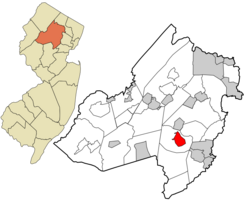
Location of Morristown in Morris County highlighted in red (right). Inset map: Location of Morris County in New Jersey highlighted in orange (left).
|
|||
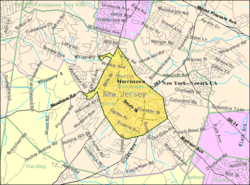
Census Bureau map of Morristown, New Jersey
<mapframe text="Interactive map of Morristown, New Jersey" zoom="8" width="250" height="250"> { "type": "ExternalData", "service": "geoshape", "ids": "Q962499" } </mapframe> |
|||
| Country | |||
| State | |||
| County | |||
| Founded | 1715 | ||
| Incorporated | April 6, 1865 | ||
| Government | |||
| • Type | Faulkner Act (mayor–council) | ||
| • Body | Town Council | ||
| Area | |||
| • Total | 3.01 sq mi (7.79 km2) | ||
| • Land | 2.91 sq mi (7.53 km2) | ||
| • Water | 0.10 sq mi (0.25 km2) 3.26% | ||
| Area rank | 333rd of 565 in state 25th of 39 in county |
||
| Elevation | 315 ft (96 m) | ||
| Population
(2020)
|
|||
| • Total | 20,180 | ||
| • Estimate
(2024)
|
20,723 | ||
| • Rank | 137th of 565 in state 9th of 39 in county |
||
| • Density | 6,937.1/sq mi (2,678.4/km2) | ||
| • Density rank | 67th of 565 in state 2nd of 39 in county |
||
| Time zone | UTC−05:00 (Eastern (EST)) | ||
| • Summer (DST) | UTC−04:00 (Eastern (EDT)) | ||
| ZIP Codes |
07960–07963
|
||
| Area code(s) | 862/973 and 201 | ||
| FIPS code | 3402748300 | ||
| GNIS feature ID | 0885309 | ||
Morristown is a town in Morris County, New Jersey. It is known as "the military capital of the American Revolution". This is because it played a very important role in America's fight for independence from Great Britain. Many historical sites in Morristown are part of Morristown National Historical Park, which was the country's first National Historical Park.
Morristown became an official town on April 6, 1865. In 2020, about 20,180 people lived there. The town's population has grown over the years. The first permanent settlement in Morristown was called New Hanover, started in 1715. Morris County and Morristown were named after Lewis Morris, a popular governor of the New Jersey colony.
Contents
Exploring Morristown's Past
Before Europeans arrived, the Lenni Lenape Native Americans lived in this area for thousands of years. European settlers from Sweden and the Netherlands came in the early 1600s. They traded furs with the native people. In 1664, the English took control of the region and named it the Province of New Jersey.
Morristown in the 1700s
English settlers from New York and Connecticut founded Morristown around 1715. They called it New Hanover. Because of its central location, Morristown became the main town of the new Morris County in 1739. Both the town and county were named after Governor Lewis Morris.
By the mid-1700s, Morristown had about 250 residents. It had churches, a courthouse, schools, stores, and mills.
George Washington first visited Morristown in 1773, before the Revolutionary War began.
The Revolutionary War in Morristown
In 1777, General Washington and the Continental Army stayed near Morristown from January to May. Washington's headquarters was at Jacob Arnold's Tavern in the town center. Morristown was a great location because it was protected by the Watchung Mountains. It was also between Philadelphia and New York. The town's people and industries could provide supplies for the army.
Churches were used to give soldiers inoculations against smallpox. Arnold's Tavern was later moved and became a hospital.
From December 1779 to June 1780, the Continental Army camped again at Jockey Hollow. This time, Washington's headquarters was at the Ford Mansion. The winter of 1780 was very harsh, with many soldiers facing hunger and illness.
During this time, in March 1780, Washington made St. Patrick's Day a holiday to honor his many Irish soldiers. Martha Washington also stayed with her husband each winter during the war. The Marquis de Lafayette visited Washington in Morristown. He brought news that France would send ships and soldiers to help the Continental Army.
Today, the Ford Mansion, Jockey Hollow, and Fort Nonsense are part of Morristown National Historical Park. This park helps preserve these important historical places.
A statue on the Morristown Green shows George Washington, the Marquis de Lafayette, and Alexander Hamilton discussing French aid. This statue reminds us of their important meeting.
Burnham Park in Morristown has a statue of Thomas Paine. He wrote Common Sense in 1776, which encouraged Americans to break away from British rule. The statue shows Paine writing during the war.
Morristown in the 1800s
The idea for the Morris Canal came from Morristown businessman George P. Macculloch in 1822. The canal was used for about 100 years.
In 1825, the Marquis de Lafayette returned to Morristown. A special event was held in his honor at the Sansay House.
St. Peter's Episcopal Church was founded in 1827. It was rebuilt starting in 1889 by famous architects.
In 1838, Samuel F. B. Morse and Alfred Vail built the first telegraph at the Speedwell Ironworks in Morristown. The first message sent was A patient waiter is no loser. This invention was a big step towards the modern Information Age.
Arnold's Tavern, Washington's first headquarters, was saved from being torn down in 1886. It was moved and later became All Souls' Hospital, the first general hospital in Morris County. The original building was lost in a fire in 1918, but a new hospital was built. Today, it is part of the Morristown Medical Center.
The Bethel African Methodist Episcopal Church was started in 1843. It was the first church for Black people in Morris County. It also served as the only school for Black children until 1870.
Jewish families began moving to Morristown in the 1850s. More came from Eastern Europe in the 1890s, leading to the creation of the Morristown Jewish Center in 1899.
The Gilded Age in Morristown
From the mid-1800s, Morristown became a popular summer spot for wealthy New Yorkers. Between 1880 and 1929, many rich families built huge estates here. Madison Avenue was even called "the street of the 100 millionaires."
In 1880, Morristown had 5,418 residents. By 1890, it grew to 8,156.
In 1889, the Market Street Mission was founded to help people in need. It continues to offer shelter, meals, and support services today.
By 1902, the New York Herald called Morristown "the Millionaire City of the Nation." Many wealthy people chose Morristown for its quiet and private atmosphere. These large estates needed many employees, from housekeepers to gardeners.
The Gilded Age ended around 1929. This was due to the high cost of keeping up the estates and the stock market crash. Many mansions were sold or closed.
Morristown in the 1900s
Since 1929, over 16,000 guide dogs for the blind have been trained in Morristown by The Seeing Eye, Inc.. This is the oldest guide dog school in the U.S.
Morristown in the 2000s
On January 5, 2009, five red lights were seen in the Morristown night sky. This caused a lot of media attention and 9-1-1 calls. On April 1, 2009, it was revealed that the lights were a hoax using helium balloons and flares. This event became known as the Morristown UFO hoax.
Morristown's Geography
Morristown covers about 3 square miles. Most of this is land, with a small amount of water.
Morristown is completely surrounded by Morris Township. This makes it one of New Jersey's "doughnut towns."
The main shopping and business area of Morristown is around a square park called the Morristown Green. This park was once a market square in colonial times.
Morristown's Climate
Morristown has a climate with hot, humid summers and moderately cold winters.
| Climate data for Morristown | |||||||||||||
|---|---|---|---|---|---|---|---|---|---|---|---|---|---|
| Month | Jan | Feb | Mar | Apr | May | Jun | Jul | Aug | Sep | Oct | Nov | Dec | Year |
| Mean daily maximum °F (°C) | 38 (3) |
40 (4) |
50 (10) |
61 (16) |
71 (22) |
80 (27) |
85 (29) |
83 (28) |
75 (24) |
65 (18) |
54 (12) |
43 (6) |
62 (17) |
| Mean daily minimum °F (°C) | 20 (−7) |
22 (−6) |
27 (−3) |
36 (2) |
46 (8) |
58 (14) |
63 (17) |
62 (17) |
51 (11) |
39 (4) |
32 (0) |
26 (−3) |
40 (5) |
| Average precipitation inches (mm) | 4.50 (114) |
3.00 (76) |
4.41 (112) |
4.64 (118) |
5.09 (129) |
4.40 (112) |
5.29 (134) |
4.37 (111) |
5.33 (135) |
4.17 (106) |
4.37 (111) |
4.10 (104) |
53.67 (1,363) |
People of Morristown
| Historical population | |||
|---|---|---|---|
| Census | Pop. | %± | |
| 1880 | 5,418 | — | |
| 1890 | 8,156 | 50.5% | |
| 1900 | 11,267 | 38.1% | |
| 1910 | 12,507 | 11.0% | |
| 1920 | 12,548 | 0.3% | |
| 1930 | 15,197 | 21.1% | |
| 1940 | 15,270 | 0.5% | |
| 1950 | 17,124 | 12.1% | |
| 1960 | 17,712 | 3.4% | |
| 1970 | 17,662 | −0.3% | |
| 1980 | 16,614 | −5.9% | |
| 1990 | 16,189 | −2.6% | |
| 2000 | 18,544 | 14.5% | |
| 2010 | 18,411 | −0.7% | |
| 2020 | 20,180 | 9.6% | |
| 2024 (est.) | 20,732 | 12.6% | |
| Population sources: 1880-1920 1880-1890 1890-1910 1880-1930 1940–2000 2000 2010 2020 |
|||
In 2020, Morristown had 20,180 people. The population included people from many different backgrounds. About 49% were White, 10% Black or African-American, and 5% Asian. About 26% of the population identified as Hispanic or Latino.
The average household size was 2.2 people. The median age in Morristown was 36.4 years old.
Morristown's Economy
Several companies have their main offices in Morristown. These include Capsugel, Reworld, Louis Berger Group, Schindler Group, and Honeywell. The Morristown & Erie Railway is also based here.
Morristown Medical Center is the largest employer in Morristown, with 5,500 employees.
Arts and Culture in Morristown
Main Attractions
- Morristown National Historical Park – This park includes four historic sites from the American Revolutionary War. You can visit Jockey Hollow, which has a visitor center, the Wick farm, and hiking trails. It was a winter camp for George Washington's army. You can also see the Washington's Headquarters & Ford Mansion, where Washington stayed.
- Speedwell Lake – A park with an old dam and other interesting ruins. The Patriots Path, a walking trail, goes through this park.
- Morristown Green – This is a park in the center of town. It has monuments from the Revolutionary War and Civil War. Historic churches, the courthouse, and many shops and restaurants surround it.
- St. Peter's Episcopal Church – A large church with a bell tower, beautiful stained glass, and old furnishings.
- Acorn Hall – An 1853 mansion that is now home to the Morris County Historical Society. It is a museum with many original items.
- Morris Museum – This museum has displays of rocks, minerals, fossils, animal mounts, a model railroad, and Native American crafts.
- Mayo Performing Arts Center – A theater that used to be a movie theater. It now hosts many live performances.
- The Seeing Eye – The first school in North America that trains guide dogs for blind and visually impaired people.
- Speedwell Ironworks – A National Historic Landmark where the electric telegraph was first shown to the public in 1838.
Libraries in Morristown
- Morristown and Morris Township Public Library – This library started informally in 1792. A fire destroyed much of its collection in 1914. A new fireproof building was built in 1916.
Historic Places
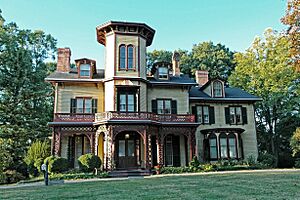
Morristown has many places listed on the National Register of Historic Places. These include:
- Acorn Hall
- Dr. Jabez Campfield House
- Morris County Courthouse
- Morristown District
- Morristown National Historical Park
- Thomas Nast Home
- Speedwell Village-The Factory
Statues and Monuments
- An equestrian statue of George Washington is near the Ford Mansion. It was dedicated in 1928.
- The Hiker statue honors soldiers from the Spanish–American War. It was placed in 1948.
- One of only two statues of Thomas Paine in the United States is in Morristown.
- A statue of Morris Frank, who helped start The Seeing Eye guide dog school, stands on the green with his dog Buddy.
- The Alliance (2007) features bronze figures of George Washington, Alexander Hamilton, and the Marquis de Lafayette on the Morristown Green.
Sports and Recreation
Morristown has a professional inline hockey team called the New Jersey Stampede.
The United States Equestrian Team was founded in Morristown in 1950.
Morristown also has a cricketing club, which was the first in North America. The Morristown 1776 Association Football Club is a soccer club.
How Morristown is Governed
Morristown is run by a Mayor-Council government system. The Town Council has seven members. Three members are elected from the whole town, and one is chosen from each of the town's four areas, called wards. They are elected for four-year terms.
As of 2024, the Mayor of Morristown is Timothy Dougherty.
Education in Morristown
The Morris School District serves students from Morristown and Morris Township. High school students from Morris Plains also attend Morristown High School.
The schools in the district include:
- Lafayette Learning Center (PreK)
- Alexander Hamilton School (grades 3–5)
- Hillcrest School (grades K–2)
- Thomas Jefferson School (grades 3–5)
- Normandy Park School (grades K–5)
- Sussex Avenue School (grades 3–5)
- Alfred Vail School (grades K–2)
- Woodland School (grades K–2)
- Frelinghuysen Middle School (grades 6–8)
- Morristown High School (grades 9–12)
Morristown also has several private schools:
- The Red Oaks School: An independent school for pre-kindergarten through eighth grade.
- Assumption Roman Catholic: A K–8 school recognized as a National Blue Ribbon School.
- The Peck School: A private day school for kindergarten through eighth grade, started in 1893.
- Delbarton School: An all-boys Catholic school for grades seven through twelve.
- Morristown-Beard School: A private co-ed school for grades 6 through 12.
- Villa Walsh Academy: A private Catholic college preparatory school for girls.
The Rabbinical College of America, a large Chabad Lubavitch yeshiva, is also located in Morristown.
Getting Around Morristown
Roads and Highways
Interstate 287 is the main highway that connects to Morristown. Other important roads include U.S. Route 202 and New Jersey Route 124.
Public Transportation
Morristown is a "transit village," meaning it has been designed to make it easy to use public transportation.
NJ Transit offers train service from the Morristown station. You can take trains to Newark Broad Street, Secaucus Junction, New York Penn Station, and Hoboken Terminal. The "Midtown Direct" service has made trips to New York City faster.
NJ Transit also provides local bus service from the Morristown rail station and other locations.
The town's Department of Public Works runs "Colonial Coach," which offers free transportation within Morristown.
Aviation
Morristown Municipal Airport is the closest public airport. It is located in nearby Hanover Township.
Newark Liberty International Airport is the closest major airport with passenger flights. It is about 20 minutes away.
Media in Morristown
Newspapers like The New York Times, The Wall Street Journal, and The Star-Ledger serve the community. The Daily Record is a local newspaper.
WMTR is an AM radio station in Morristown that plays oldies music. WJSV radio (90.5 FM) is the non-profit radio station of Morristown High School.
Notable People from Morristown
Many interesting people have connections to Morristown, including:
- William O. Baker (1915–2005), a scientist who led Bell Labs.
- James Berardinelli (born 1967), a film critic.
- Scott Blumstein (born 1992), a poker player who won the 2017 World Series of Poker.
- Lincoln Child (born 1957), an author of thrilling novels.
- Joe Dante (born 1946), a film director.
- Dorothy Harrison Eustis (1886–1946), who founded The Seeing Eye guide dog school.
- Nic Fink (born 1993), an Olympic swimmer.
- Steve Forbes (born 1947), editor-in-chief of Forbes magazine.
- Caroline Rose Foster (1877–1979), a farmer who created Fosterfields, a historical farm.
- Justin Gimelstob (born 1977), a professional tennis player.
- Anna Harrison (1775–1864), a former First Lady of the United States.
- Tobin Heath (born 1988), a World Cup Champion and Olympic soccer player.
- Linda Hunt (born 1945), an Academy Award-winning actress.
- Julia Hurlbut (1882–1962), a suffragist who worked for women's right to vote.
- Otto Hermann Kahn (1867–1934), a German-born banker and philanthropist.
- Nolan Kasper (born 1989), an alpine ski racer.
- Dorothy Kunhardt (1901–1979), a children's book author.
- Fran Lebowitz (born 1950), an author and actor.
- Troy Murphy (born 1980), a professional basketball player.
- Thomas Nast (1840–1902), a famous caricaturist and cartoonist.
- Craig Newmark (born 1952), the founder of Craigslist.
- Neil O'Donnell (born 1966), a former NFL quarterback.
- Rick Porcello (born 1988), a professional baseball pitcher.
- Robert Randolph, a guitarist.
- Garrett Reisman (born 1968), a NASA astronaut.
- Rick Rescorla (1939–2001), a security expert who helped people during the September 11 attacks.
- Gene Shalit (born 1926), a film critic.
- Lexington Steele (born 1969), an actor and director.
- Alfred Vail (1807–1859), an inventor of Morse code.
- George Theodore Werts (1846–1910), a former Governor of New Jersey.
- Liv Morgan (born 1994), a professional wrestler.
See also
 In Spanish: Morristown (Nueva Jersey) para niños
In Spanish: Morristown (Nueva Jersey) para niños


